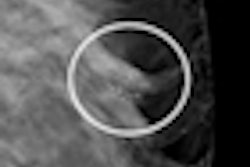CHICAGO - Digital breast tomosynthesis (DBT) is proving equivalent to full-field digital mammography (FFDM) in finding and identifying cancer. But challenges to clinical use remain, according to Mark Helvie, MD, professor of radiology and director of breast imaging at the University of Michigan Health System in Ann Arbor.
Helvie outlined some of the benefits and challenges of DBT in a Wednesday morning course at the RSNA meeting. His overview was followed by a number of presentations that support DBT's efficacy.
DBT has become a large and expanding field, Helvie said, and because it eliminates the problem of overlapping tissue on breast images that plagues mammography, it's beneficial for women with dense breast tissue -- for whom mammography has lower sensitivity. It can identify and characterize masses and noncalcification better than mammography and theoretically can reduce the recall rate. And it has clinical trial data to back up its effectiveness, according to Helvie.
"Tomosynthesis is a branch of mammography that has randomized, controlled trials that prove its benefit for women's survival of breast cancer," he said. "And at least in experimental situations, research has found that it can reduce the recall rate by 40% to 43%."
But the technology's challenges include where it stands vis-à-vis Medicare reimbursement and the training it requires, Helvie told session attendees.
"This technology feels similar to mammography, but it's different enough that we will have to develop training [protocols]," he said. "It's like having a cousin -- you know him, but not that well."
DBT equivalent to FFDM
In one of the session presentations, Michael Fishman, MD, of Albert Einstein Medical Center in Philadelphia, and colleagues compared the accuracy of the two modalities in finding both noninvasive and invasive breast cancer. For the study, which included a group of 70 women with lesions categorized as BI-RADS 4 or 5, the team used an investigational Selenia Dimensions device (Hologic, Bedford, MA).
"Mammography is our workhorse [modality for cancer detection], but it has its limitations," Fishman told session attendees. "We've been studying DBT since late 2008 at our institution, exploring whether the technology can reduce [the tissue overlap often found on mammography images], offer superior image quality for masses and asymmetry, and perhaps offer superior visibility and improved margin definition as well."
Of the 70 women in the study, 35 had 40 malignancies. Of these cancers, 17 were invasive, six were ductal carcinoma in situ, and 17 were both. The average lesion size was 30 mm.
Both modalities had the same rate of detection, at 38 cancers out of 40. DBT missed one fibroglandular lesion, FFDM missed one dense tissue lesion, and both modalities missed one heterogeneous lesion. DBT had seven false positives, of which six were heterogeneous and one was fibroglandular.
"We found no statistically significant difference between the two modalities in determining the extent of disease," Fishman said.
DBT plus FFDM boosts mammo performance
If using DBT is equivalent to FFDM in identifying the extent of breast cancer, adding it to FFDM increases mammography's performance, according to a related study presented during the session.
Researchers from the National Cancer Center in Tokyo compared the performance of DBT plus FFDM to FFDM alone, finding that the combination was not negatively affected by breast tissue density.
Nachiko Uchiyama, MD, and colleagues conducted the study between October 2009 and February 2010 and included 55 women with 58 lesions. The women received full-field digital mammograms from an amorphous selenium digital detector FFDM system and two-view DBT exams performed with the same compression angle and compression pressure as the FFDM exams. Twenty-nine (52.7%) of the women had fatty or scattered breast tissue (BI-RADS density 1 to 2); 26 women (47.3%) had heterogeneously dense or extremely dense breast tissue (BI-RADS density 3 or 4).
Uchiyama's group found that, alone, FFDM's average detection rate was 82.8%, while the rate of detection for FFDM plus DBT was 98.3%.
Detection rate by modality and breast density
|
"Combining FFDM with DBT proved useful, without breast density being a significant factor," Uchiyama said.
By Kate Madden Yee
AuntMinnie.com staff writer
December 1, 2010
Related Reading
Combined x-ray and optical tomography improve breast imaging, November 9, 2010
Hybrid breast imaging unit melds molecular and x-ray tomo, April 5, 2010
Can DBT unseat MRI for screening high-risk women? March 22, 2010
Adding DBT to mammo increases cancer detection in dense breasts, January 18, 2010
DBT reduces false-positive rate by 41% in screening setting, December 1, 2009
Copyright © 2010 AuntMinnie.com




















